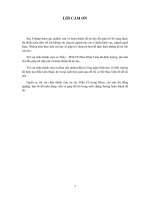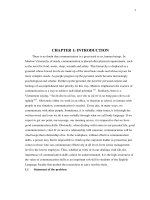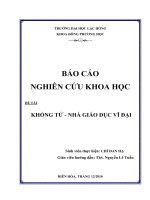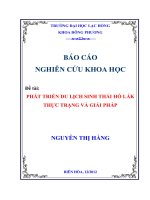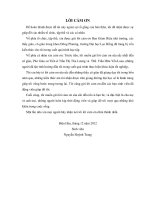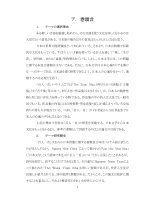Báo cáo nghiên cứu khoa học: "MICROWAVE-ASSISTED EXTRACTION OF POLYPHENOLS FROM FRESH TEA SHOOT" pps
Bạn đang xem bản rút gọn của tài liệu. Xem và tải ngay bản đầy đủ của tài liệu tại đây (332.03 KB, 7 trang )
TẠP CHÍ PHÁT TRIỂN KH&CN, TẬP 9, SỐ 8 -2006
Trang 69
MICROWAVE-ASSISTED EXTRACTION OF POLYPHENOLS FROM FRESH
TEA SHOOT
Pham Thanh Quan
(1)
, Tong Van Hang
(2)
, Nguyen Hai Ha
(1)
, Nguyen Xuan De
(1)
,
Truong Ngoc Tuyen
(1)
(1)University of Technology, VNU-HCM
(2) International University, VNU-HCM
(Manuscript Received on January 26
th
, 2006, Manuscript Revised August 21
st
, 2006)
ABSTRACT: Fresh tea shoots (one shoot and two or three young leaves) were extracted
using microwave-assisted extraction method (MAE). Several factors such as ethanol
concentrations (0-99.5
o
(volume percentage)), material: solvent ratio (1:4 to 1:12), extraction
time, oven power were studied to optimise conditions at laboratory scale. MAE archived good
yield (82.46 %) after 6 minutes microwave radiation, that was higher than that of extraction at
room temperature in 24 hours, conventional heating extraction at reflux temperature in 60
minutes or ultrasound-assisted extraction in 60 minutes. Afterward, MAE method was
employed to investigate five types (LD97, LDP1, PH1, TB14, HAT) of tea (Camellia sinensis
(L.) O. Kuntze) from Bao Loc, Lam Dong. HAT (20.49 % dried weight of total catechins) was
found as suitable material for polyphenols extraction.
Keywords:
Polyphenols, catechins, tea extract, extraction, microwave-assisted extraction.
1. INTRODUCTION
Tea has been one of the most consumed beverages in all over the world. Tea is used not
only as fresh drink but also as traditional herb which has many benefits for human health.
Recently tea has attracted scientific attention for its anticancer and antioxidant activities [10].
Polyphenols in green tea are believed as excellent free radical scavengers. Several clinical
studies have proved polyphenols to be active in cancer prevention in several ways. Polyphenols
have also been recently recognized as functionally active molecules, possessing antioxidant,
anticancer, anti-mutagenic properties, as well as exerting protective effects against
cardiovascular and other diseases [13,15].
This is primary because of the affect of polyphenols, tea main components, which may be
as high as 30 – 35 % in dried weight of fresh tea shoots [2, 18, 20]. Tea polyphenols consist of
several types of catechins compounds (usually 5 or 6, in some tea breeds the number of
catechins compounds are 8, 9 or more), including C, EC, EGC, ECG, EGCG, ECG….[3, 8, 20].
These catechin compounds have showed strong antioxidant activity, especially in free radical
scavenger acting (oxy singlet, triplet, hydroxyl, superhydroxyl…) and metal chelating (to
prevent catalyst effect of metal ion in oxidative reactions) [16].
Conventional methods for extraction of tea polyphenols have been reported [12, 17, 19].
Microwave-assisted extraction, which has been recently successfully used for extract
biologically active compounds [11, 14], has been studied for extraction polyphenols from tea.
There is already a report done on the use of MAE for extraction of tea polyphenols [8].
Commercial dried green tea was used as material for extraction, and higher yield was achieved
in shorter time in MAE compare to those of conventional methods. However, dried green tea,
which require long process and is an expensive material, may not suitable for polyphenols
extraction at large scale.
Nowadays, tea extract and polyphenols from tea have become common products in several
countries such as China, Japan, Indian…However, tea extract is still new in Vietnam market
and also new in research and application. The purpose of this work is to evaluate MAE method
Science & Technology Development, Vol 9, No.8- 2006
Trang 70
for extracting polyphenols from tea and apply this method to investigate several tea resources
in Bao Loc, Lam Dong.
2. MATERIALS AND METHODS
2.1. Materials
Fresh tea (picked as shoots with two or three leaves) from Bao Loc, Lam Dong, was kindly
provided by Minh Rong Tea Company. Tea was inactivated enzyme by steaming for 90
seconds before using.
Folin - Ciocalteu agent (Merck), (+)-catechin, (-)- epicatechine, (-)-epicatechin gallate, (-)-
epigallocatechin gallate, caffeine (98% HPLC, Aldrich – Sigma), ethanol and other chemical
were analytical purity grade.
2.2. Microwave assisted extraction (MAE)
Experiments were carried out in a domestic microwave oven (Whirpool Oven, power 450,
600, 800 W), which was modified for using in laboratory [1]. 100 g of tea (which had been
inactivated enzyme before) were cut and grinded to small size, then mixed with solvents in
suitable ratio. The suspension was radiated in microwave oven at regular intervals (one minute
radiation and two minutes off) to keep temperature not rise above 80
o
C. The infusions were let
to cool down to room temperature, filtered and stored in refrigerator at 4
o
C for determine total
polyphenols later.
Other extraction method in comparison included conventional heating reflux extraction
method, ultrasound-assisted extraction and extraction at room temperature.
2.3. Total polyphenols determination
Folin-ciocalteu method, is one of several methods which are used to determine total
polyphenols [6, 20]. Polyphenols reduce Folin agent (yellow solution of
polyphosphatetungstenate and molydate) in mild base medium to form deep blue color. The
procedure was modified from [6], as follow :
- 0.5 ml of sample (distilled water is used for blank) was added to 10 ml flask, and
diluted with 4.5 ml distilled water. Next, 0.2 ml Folin agent, 0.5 ml saturated Na
2
CO
3
solution
were added, respectively. The solution was shaken, added water to 10 ml and left for color
development in 1 hour. After that, solution was measured at 725 nm in Jenway 6505 UV-VIS
spectrophotometer.
-
Total polyphenols content was calculated from absorption value and linear regress
equation using acid gallic as standard. Results was shown as ppm GE (Gallic acid Equivalent)
2.4. Catechins determination
Catechins were measured using HPLC method described in previous literature with
modified [3, 5, 7, 17]. Analyses were performed on an HPLC 1100 Agilant, with C18 column
(Synergi Hydro-RP 80R, Phenomenex, US) and UV detector (230 nm). Eluent A was
acetonitril (ACN) and eluent B was 0.1 % aqueous phosphoric acid, the flow rate was kept
constant throughout the analysis at 1 ml. min
-1
. The elution programme was used as following:
Time (minute)
: 0 10 10.1
ACN : 5 40 5
H
3
PO
4
(0.1 %) : 95 60 95
Chromatograms were monitored at 230 nm and identification was based on retention times
in comparison with authentic standards. Quantification was performed by establishing
calibration curves for each compound determined, using standards.
TẠP CHÍ PHÁT TRIỂN KH&CN, TẬP 9, SỐ 8 -2006
Trang 71
124.11
381.48
451.34
490.00
473.66
500.00
520.00
531.70
528.13
0
100
200
300
400
500
600
0o 10o 20o 30o 40o 50o 60o 80o 99,5o
Ethanol concentration
Polyphenol conc. (ppm)
16.31
19.36
18.46
19.10
18.10
21.05
20.63
0.00
5.00
10.00
15.00
20.00
25.00
1:04 1:06 1:07 1:08 1:09 1:10 1:12
Material/solvent ratio (g/ml)
% dried wieght
3. RESULTS AND DISCUSSION
3.1. Microwave-assisted extraction
3.1.1. Effect of ethanol concentration on the extraction of polyphenols
Ethanol was employed in experiment because it is non-toxic and inexpensive solvent.
Results on figure 1 showed that the extraction of polyphenols from tea was influenced by
ethanol concentration in water. When ethanol concentration increased from 0 to 60
o
,
polyphenols content in the extract increased significantly. Further increase of ethanol
concentration was only affected in slightly increase of polyphenols content. This result
contradicted with that of [8], the extraction was decreased with the increase of ethanol
concentration.
Besides polyphenols content, the color of extracts changed from greenish yellow to deep
green color when the volume of ethanol percentage was higher than 60
o
, which indicated that
more undesirable compounds, primary chlorophyll, were also extracted. Therefore, it was
decided to use ethanol 60
o
as extraction sovent in the following experiments.
Figure 1. Effect of ethanol concentration on the
extraction of polyphenols. Material: solvent ratio =
1:6 (g/ml), solvent volume 150 ml, radiation time:
6 minutes, 800 W power
Figure 2. Effect of material/solvents ratio on
the extraction of polyphenols. Solvent ethanol
60
o
, volume 150 ml, radiation time: 6
minutes, 800 W power.
3.1.2. Effect of material/solvents ratio on the extraction of polyphenols
It was found that material/solvent ratio did not have much effect to yield of the extraction.
Figure 2. showed that the extraction was increased with the increase of material/ solvent ratio
from 1:4 to 1:6, afterward, yield of extraction was slightly decreased, from 19.36 to 18.10 with
ratio increased from 1:6 to 1:8, then increased, from 18.10 to 21.06 with ratio 1:10. Using high
ratio of material/solvent could help achieve high yield of extraction (i.e. 1:10), however large
amount of solvent resulted polyphenols content in the extract was unnecessary low. Therefore,
material/solvent ratio of 1:6 was sufficient for the experiment. This ratio was much lower than
suitable ratio in [8] (1:20), it could be explained that material used in this experiment was fresh
tea shoot with 75 – 80 % humility, while as material used in [8] was dried green tea (humility
usually from 5 to 7 %).
3.1.3.Effect of radiation time on the extraction of polyphenols
Polyphenols concentration in the extracts was rapidly increased in the first 6 minutes of
extraction (Figure 3). Further radiation was only slightly increased polyphenols concentration.
Hence it was unnecessary to carry experiments with more than 6 minutes radiation (In [8], it
took only 4 minutes to obtained highest level of polyphenols concentration in extract). It was
also found that using higher oven power could achieved better yield with shorter times (4
Science & Technology Development, Vol 9, No.8- 2006
Trang 72
0
100
200
300
400
500
600
700
800
900
0.00 2.00 4.00 6.00 8.00 10.00 12.00 14.00
Radiation time (minute)
Polyphenol conc. (ppm
)
450W 600W
800W
82.46
8.91
6.55
2.08
0
10
20
30
40
50
60
70
80
90
First Second Third Fourth
Extraction yiled (%)
minutes at 800 W gave similar yield as 6 minutes at 450 W) (In [8], microwave oven with full
power 700 W was employed in experiments).
Figure 3. Effect of radiation time on the extraction
of polyphenols. Solvent: ethanol 60
o
volume 150
ml, material: solvent ratio 1:6 (g/ml)
Figure 4. Yields of extraction in consecutive
times. Solvent: ethanol 60
o
, volume 150 ml,
material: solvent ratio 1:6 (g/ml), radiation
time: 6 minutes, 800 W power.
3.1.4. Yields of extraction in consecutive times
This procedure was repeated several times until water did not change color when adding
drops of indicator solution FeCl
3
3 % / HCl 0.1 N (dark blue color appears if there are
polyphenols in water) to extract all polyphenols in tea material. Figure 4 shows that yield in the
first extraction (82.40 %) is much higher than that of following extraction (8.91 %, 6.55 %,
2.06 % in the second, third and fourth time, respectively). This result was demonstrated high
yield of MAE method.
3.1.5. Comparison of the results of extraction with MAE and other methods
Other extraction procedures (conventional heating reflux extraction method, ultrasound-
assisted extraction and extraction at room temperature) were carried out for comparison to
MAE. Results in table 1 showed that yield (82.46 %) of MAE for 6 minutes radiation (18 total
time of extraction) higher than that of ultrasound-assisted extraction in 60 minutes,
conventional heating reflex extraction in 60 minutes and extraction at room temperature in 24
hours (63.3 %, 65.64 % and 49.39 %, respectively).
Table 1. Comparison of the results of extraction with MAE and other methods
Method Time Catechins Yields(%)
MAE 6 minutes 16.90 (% dried weight) 82.46 %
Conventional heating reflux 60 minutes 13.45 65.64
Ultrasound-assisted 60 minutes 12.97 63.30
Extraction at room temperature 24 hours 10.12 49.39
Solvent : ethanol 60
o
, volume 150 ml; material : solvent ratio 1:6 (g/ml); MAE : radiation time 6
minutes, 800 W power; conventional heating reflux extraction at boiling point, using magnetic stirrer;
room temperature : 30
o
C; ultrasound-assisted at 30
o
C.
3.2. Catechins content in tea
3.2.1. HPLC determination of catechins in tea extract
To investigate tea extract, caffeine and four catechins were chosen, their content were
determinated by reversed-phase HPLC. In experiment, the peaks correspondent to catechin (C),
epicatechin (EC), epicatechin gallate (ECG), epicagallocatechin gallate (EGCG) and caffeine
TẠP CHÍ PHÁT TRIỂN KH&CN, TẬP 9, SỐ 8 -2006
Trang 73
could be separated, identified and quantified. In HPLC chromatograph, besides five peaks
already identified, several minor peaks were also detected, which indicated other catechin
compounds in extract. It was found that the similarity of HPLC chromatographs indicated the
similarity in catechin components in all five tea breeds in Bao Loc, Lam Dong.
Figure 5. Typical HPLC trace of tea extract, recorded at 230 nm. Peak assignment: 6.331, catechin;
6.634, caffeine; 7.070, epicatechin; 7.264, epigallocatechin gallate; 8.651, epicatechin gallate.
3.2.2. Comparison of tea resources
The results showed that HAT tea had the highest amount of catechin compounds (C + ECG
+ EC + EGCG = 20.49 %) higher than that of LD97, PH1, LDP1, TB14 (14.32 %, 16.09 %,
16.32 % and 15.26 % respectively). Therefore, HAT tea should be used as material for
extraction.
Among four catechin compounds identified, the most abundant catechin compound was
epigallocatechin gallate (which accounting for 80 % of total catechins in HAT, PH1 and LDP1,
65 % in LD97 and TB14, followed by epicatechin gallate (around 12 – 18 % of total catechins)
and epicatechin (7 -12 %). By constract, catechin was only minor constituent (6 % in LD97, 2.4
% in PH1, 2.6 % in TB14, 0.9 % in HAT, 0.5 % in LDP1).
It was also observed that caffeine distributed evenly among five tea origins (from 2.5% to
3.3%). In constract with catechins, caffeine amounts may not depend on tea origins or
conditions of the experiments.
Table 2. Analytical catechin compounds and caffeine of tea extracts
Catechin
(% dried weight)
Tea breeds
C EC EGCG ECG Total
Caffeine
(%dried weight)
LD97 0.87 1.78 9.11 2.56 14.32 2.8
PH1 0.39 0.93 12.85 1.92 16.09 3.3
HAT 0.19 1.52 16.30 2.48 20.49 3.2
LDP1 0.08 1.03 13.57 1.63 16.32 2.5
TB14 0.41 1.94 10.09 2.82 15.26 3.1
Science & Technology Development, Vol 9, No.8- 2006
Trang 74
Solvent : ethanol 60
o
, volume 150 ml; material : solvent ratio : 1:6 (g/ml); MAE : radiation
time : 6 minutes, 800 W power.
4. CONCLUSION
Conditions of MAE method were studied and established. MAE method was proven as
more effective than other conventional methods for extracting polyphenols from tea. MAE
method provided higher yield in shorter times (82.4 % after 6 minutes radiation).
MAE method was employed to extract five type of tea from Bao Loc, Lam Dong. HPLC
analysis of the extract showed the similarity of catechin compounds in all five tea origins, in
which EGCG and ECG were the main components. HAT tea, with the highest amount of
EGCG and total catechins, could be used as suitable material for extraction
ACKNOWLEDGMENTS: We gratefully acknowledge the financial support from HCM City
Vietnam National University. We also extend special thanks to Mr Nguyen Huu Giang, Minh
Rong Tea Company for kindly providing tea material.
TRÍCH LY CÓ HỖ TRỢ VI SÓNG CÁC POLYPHENOL TỪ BÚP TRÀ TƯƠI
Phạm Thành Quân
(1)
, Tống Văn Hằng
(2)
, Nguyễn Hải Hà
(1)
, Nguyễn Xuân Đề
(1)
Trương Ngọc Tuyền
(1)
(1)Trường Đại Học Bách Khoa, ĐHQG-HCM
(2) Trường Đại học Quốc tế, ĐHQG-HCM
TÓM TẮT: Phương pháp trích ly có hỗ trợ vi sóng được sử dụng để trích ly polyphenol
từ búp trà tươi (búp và 2, 3 lá non). Các thông số liên quan như nồng độ ethanol (0-99.5
o
(%
theo thể tích)), tỉ lệ nguyên liệu : dung môi (g/ml), thời gian trích ly, công suất lò vi sóng được
khảo sát để xác định điều kiện thích hợp cho quá trình trích ly polyphenol từ trà. Phương pháp
trích ly có hỗ trợ vi sóng thu được hiệu quả trích ly tốt (82.46 % sau 6 phút chiếu vi sóng), cao
hơn phương pháp trích ly bằng gia nhiệt thông thường trong 60 phút , phương pháp trích ly có
hỗ trợ siêu âm sau 60 phút hay phương pháp ngâm trích sau 24 giờ. Sau đó, phương pháp trích
ly có hỗ trợ của vi sóng được sử dụng để khảo sát 5 loại nguyên liệu LD97, LDP1, PH1, TB14,
HAT trà (Camellia sinensis (L.) O. Kuntze) từ vùng trà Bả
o Lộc, Lâm Đồng. Giống trà HAT
(có hàm lượng catechin cao nhất 20.49 % khối lượng khô) thích hợp làm nguyên liệu trích ly.
REFERENCES
[1]. Andre Loupy, Tran Kim Quy, Le Ngoc Thach, Phương phap hoc moi ve tong hop huu
co
, HCM City University of Natural Science, Viet Nam, 1995.
[2].
Tong Van Hang, Co so sinh hoa va ki thuat che bien tra, HCM City, Viet Nam, 1985.
[3].
Lawrance Peter Wright, Biochemical analysis for identification of quality in black tea
(Camellia sinensis)
, Doctoral Thesis, University of Pretoria, South Africa, 2005.
[4].
Zohar Kerem, Hilla German-Shashoua, Oded Yarden, Microwave-assisted extraction of
bioactive saponins from chickpea (Cicer arietnum
L.), J. Sci. Food Agric. 85, 406 –
412, 2005.
[5].
Joung Ho Ko, Gyoung Won Kang, You Jin Seo, Won Jo Cheong, C18 attached silica
monolith microcolumns made in stainless steel tubing and their application in analysis
of flavonoids in green tea extracts
, Bull. Korean Chem. Soc. 25 (10), 2004.
TẠP CHÍ PHÁT TRIỂN KH&CN, TẬP 9, SỐ 8 -2006
Trang 75
[6]. Jan Wollgast, The contents and effects of polyphenols in chocolate, qualitative and
quantitative analys of polyphenols in chocolate and chocolate raw products as well as
evaluation of potential implications of chocolate consumption in human health
,
Doctoral thesis, Jutus Liebig University of Giessen, Germany, 2004.
[7].
Kai On Chu, Chi Chiu Wang, Micheal Scott Rogers, Kwong Wai Choy, Chi Pui Pang,
Determination of catechins and catechin gallates in biological fluids by HPLC with
colormetric array detection and solid phase extraction
, Analytica Chimica Acta 510, 69
– 76, 2004.
[8].
Xuejun Pan, Guoguang Niu, Huizhou Liu, Microwave-assisted extraction of tea
polyphenols and tea caffeine from green tea leaves
, Chemical engineering and
processing 42, 129 – 133, 2003.
[9].
Carmen W. Huie, A review of modern sample-preparation techniques for the extraction
and analysis of medicinal plants
, Anal. Bioanal. Chem. 373, 23 – 30, 2002.
[10].
Hirota Fujikia, Masami Suganumab, Kazue Imaic, Kei Nakachic, Green tea: cancer
preventive beverage and/or drug,
Cancer Letters 188, 9 –13, 2002.
[11].
E.Surducan, Camellia Neamtu, V. Surducan, Gabiela Nagy, S.Filip, Microwave power
assisted sample preparation, extraction studies
, Studia Universitatis Babes-Bolyai,
Physica, Special Issue, 2001.
[12].
David T. Bailey, Parh L. Yuhasz, Bo Lin Zheng, Method for isolation caffeine –free
catechins from green tea
, US patent 6.210.679, 2001.
[13].
John H. Weisburger, Tea and health: a historical perspective, Cancer Letters 114, 315 -
317, 2000.
[14].
M.Letellier, H. Budzinski, Microwave-assisted extraction of organic compounds,
Analysis (Wiley – VCH) 27, 258 - 271, 1999.
[15].
Michael D. Brown, Green Tea (Camellia Sinensis) Extract and Its Possible Role in the
Prevention of Cancer
, ND Alternative Medicine Review, Vol. 4 (5), 1999.
[16].
Qiong Guo, Baolu Zhao, Shengrong Shen, Jingwu, Jungai Hu, Wenjuan Xin, ERS study
on the structure – antioxidant activity relationship of tea catechins and their epimers
,
Biochimia et Biophysica Acta 1427, 13 - 23, 1999.
[17].
Yuko Yoshida, Masaaki Kiso, Tetsuhisa Goto, Efficiency of the extraction of catechins
from green tea,
Food Chemistry 67, 429 - 433, 1999.
[18].
Edwin Haslam, Plant polyphenols, Cambridge University Press, 1992.
[19].
Yukihiko Hara Shizuoka, Process for the production of tea catechins, US patent
4.613.672, 1986.
[20]. T.A. Geissman, The Chemistry of Flavonoid compounds, New York, USA, 1962.

